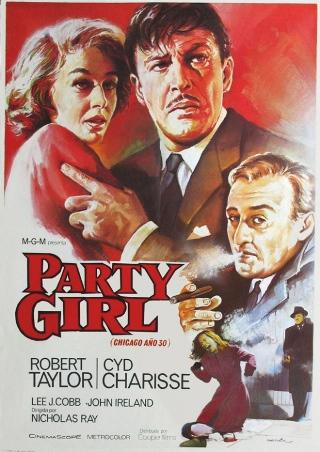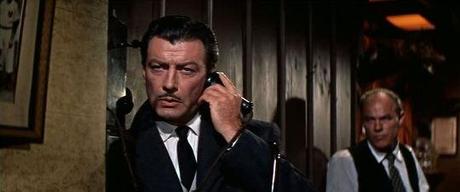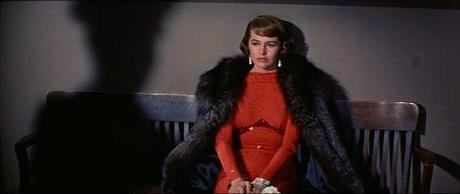
Last time, I had a look at a gangster/noir crossover movie, an early example of the emergence of a darker sensibility in crime movies in Hollywood. Let’s jump ahead almost two decades, to the point at which film noir was nearing the end of the classic cycle. Again, the film in question is something of a hybrid, a fusion of styles and influences, but the principal elements remain the gangster story and shadowy world of the dark cinema. A lot of film noir throughout the 1950s featured the involvement of organized crime so Party Girl (1958), despite abandoning the more usual contemporary setting, can be viewed as a continuation of that trend. Having said that, the movie could be classed as a marginal entry – it’s shot in lurid technicolor and at times resembles a hard-boiled variation of the classic studio musical. However, in spite of what sound like stylistic contradictions, Party Girl is categorized by many writers as a genuine film noir, and I guess its themes do have the requisite darkness and ambiguity to qualify it for inclusion.
Chicago in the early 30s – Tommy Farrell (Robert Taylor) is a mob lawyer, and a successful one. He’s respected and feared by judges and prosecutors not simply due to his connections but because he’s the top man in his line. Farrell is first glimpsed at a party thrown by crime kingpin Rico Angelo (Lee J Cobb) – actually it’s as much a wake as a party since Rico is laying to rest a broken heart on hearing the news that Jean Harlow, whom he’s adored from afar, is to be wed – and he’s surrounded by a group of city dignitaries hanging onto his every word. One might assume that Farrell has it made, but this is only the silver lining obscuring the cloud. Farrell is almost a cripple, his hip and leg twisted as a result of a youthful escapade gone wrong. It is often the case in movies that physical imperfections are mirrored by deeper psychological scars, and so it is with Tommy Farrell. This man who glides effortlessly through the powerful social milieu in spite of his pronounced limp is emotionally wounded. His beautiful but callous wife left him since she couldn’t overcome her disgust at his physical deformity, and Farrell has been unable to heal that emotional wound. However, his rehabilitation begins at Rico’s party when he agrees to escort home Vicki Gaye (Cyd Charisse), a dancer and one of the “party girls” hired for the evening. Although the evening ends with a rather gruesome discovery, Farrell and Vicki do make a connection that will blossom despite a few bumpy stretches along the way. The whole movie is principally concerned with Farrell’s rediscovery of his self-respect after years of loathing himself. Running parallel to the developing relationship with Vicki is the thread that follows Farrell’s attempts to distance himself from Rico and the corrupt and violent world he inhabits. Just when it looks like the hero may have achieved the spiritual peace he’s long been seeking, Rico’s machinations and threats haul him back to defend one of his paymaster’s psychotic associates. However, having had a taste of life beyond the cheap neon glamour of the underworld, Farrell is determined to get out for good. The trick is to find a way to protect Vicki, bring down Rico, and save his own skin at the same time.

Nostalgia for certain periods tends to come in waves, and the late 50s saw a resurgence of interest in the old gangster movies. Party Girl tapped into that vibe and director Nicholas ray added his own personal touch to it. Ray only made a handful of noir pictures altogether – all are interesting in their own way, and two (In a Lonely Place and On Dangerous Ground) are pure bred classics. All of Ray’s best movies dealt with those who were in some way removed from the mainstream of society, and Party Girl follows that template. Farrell is superficially a man at the heart of city life. Yet, he’s an outsider in every sense; a lawyer who essentially makes a mockery of the law, an apparent mob insider who is revolted by the crassness and brutality around him, and a man bedeviled by his own sense of inadequacy. Aside from the fact that the mobsters and hoodlums who populate the film are themselves social pariahs, Vicki is another character existing at the periphery of decency. The struggle which Farrell and Vicki undertake to break free of the dark influences that threaten to drag them down is classic Ray material. Another feature common to Ray’s work, and seen in abundance here, is the unrestrained use of color. Party Girl is a riot of technicolor hues that seem to allude to the heightened emotional state of the characters.

Even though I’m a great admirer of his work in general, I think it’s fair to say Robert Taylor gave an excellent performance as Farrell. As he aged, and his looks took on more character, he did some first-rate work in westerns, and the same can be said about his noir pictures. He brought a dour toughness to his role as the tortured lawyer, and worked well with Charisse. For her own part, Charisse adopted the right kind of world-weary air that befits a woman who has spent her time dodging unwanted passes and living off dubious handouts in seedy nightclubs. She was of course an immensely talented dancer, one of the greats, and the movie features a couple of set piece numbers designed to show off her moves. With the club setting, and her character’s profession, these sequences are blended seamlessly into the narrative. They may capture the look and feel of a musical yet they never have that jarring, artificial sense that such movies frequently evoke. The other big hitter in the cast was Lee J Cobb. This was an actor who could explode out of the screen at times, his inherent power always in danger of turning into bombast. In Party Girl, Ray managed to get the right kind of balance from Cobb for the most part. Sure there are instances where he drifts awfully close to scenery chewing, but there are some quietly effective moments too – his chat with Taylor where he blackmails the lawyer into cooperating under the threat of disfiguring his girlfriend is all the more chilling due to Cobb’s restraint. The supporting cast was headed up by the ever reliable John Ireland as Cobb’s slimy and dangerous right hand man. Also featured were Kent Smith – despite his long and varied career, I’ll always associate him with one of his earliest roles in Val Lewton & Jacques Tourneur’s Cat People – as the straight arrow prosecutor, and a manic Corey Allen as the unbalanced hood Cookie La Motte.
For a long time, Party Girl wasn’t the easiest movie to see. However, it has been released on DVD in France and Spain and as a MOD disc via the Warner Archive in the US. I have the old French Warner Brothers DVD which is pretty good. The film is presented in anamorphic scope and the print used for the transfer seems in good shape. There’s plenty of clarity, the colors are strong and quite vibrant, and damage (if there is any) is so slight I can’t say I noticed. There are no extra features on the disc – subtitles are optional and can be disabled via the setup menu. The blending of styles and genres just about works in the movie, drawing in elements of melodrama, the musical and a crime tale to create a fairly unique film noir. Aside from a trio of good performances, what holds the whole thing together is the direction of Nicholas Ray. In the hands of a lesser director, the disparate elements could well have pulled the movie apart. As it stands, Party Girl remains one of Ray’s interesting experiments which I feel more or less succeeds. Of course much of this depends on how one reacts to Ray as a filmmaker; as such, it’s another of those films that I’d cautiously recommend.
